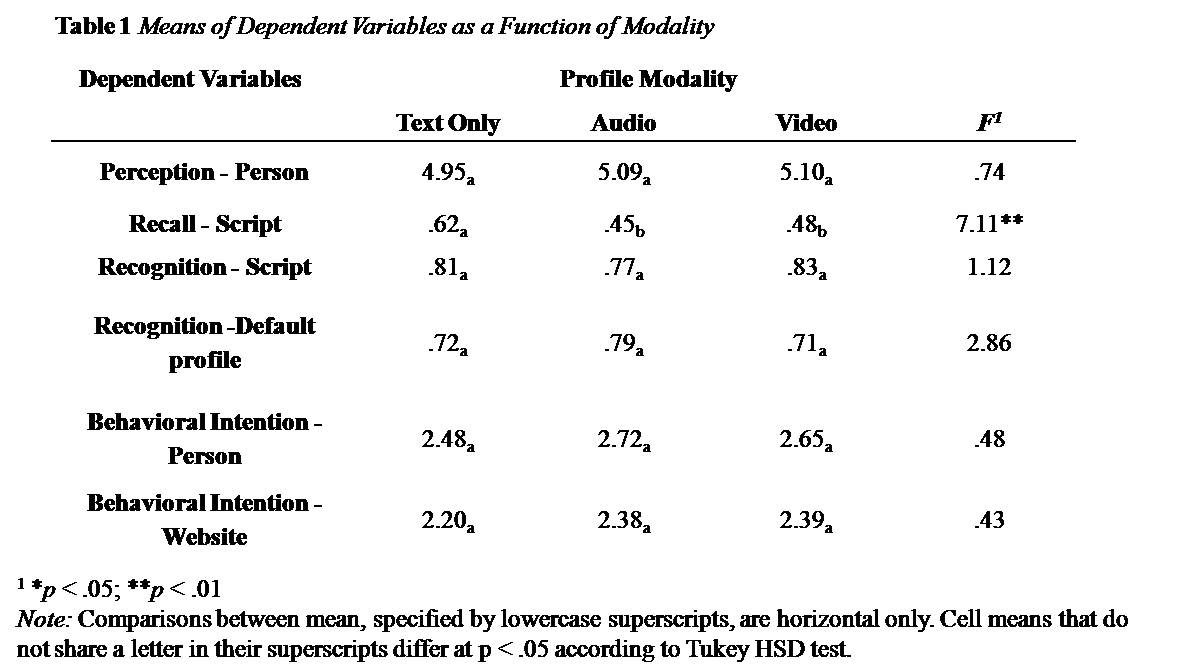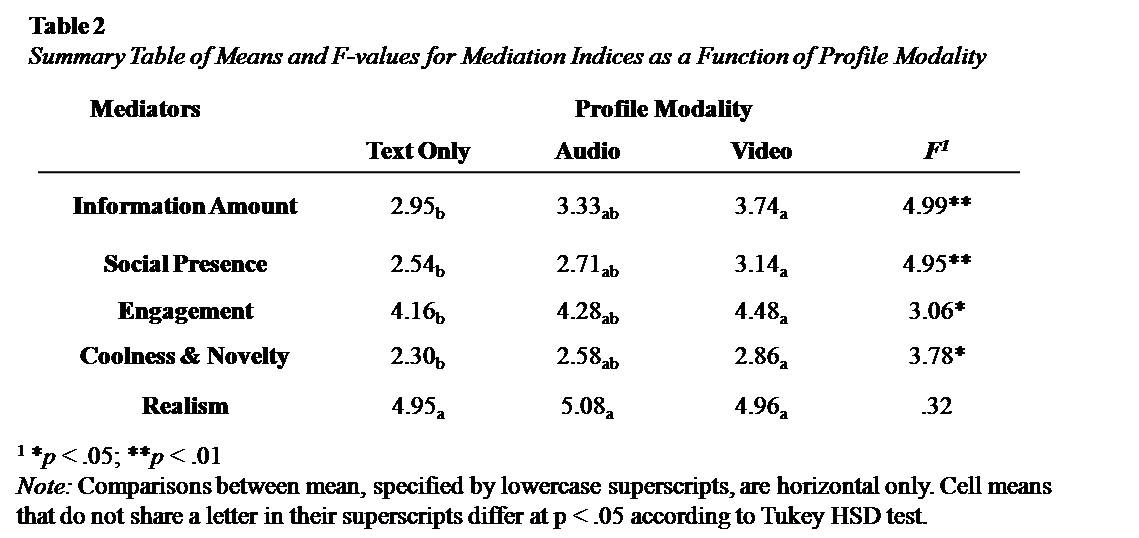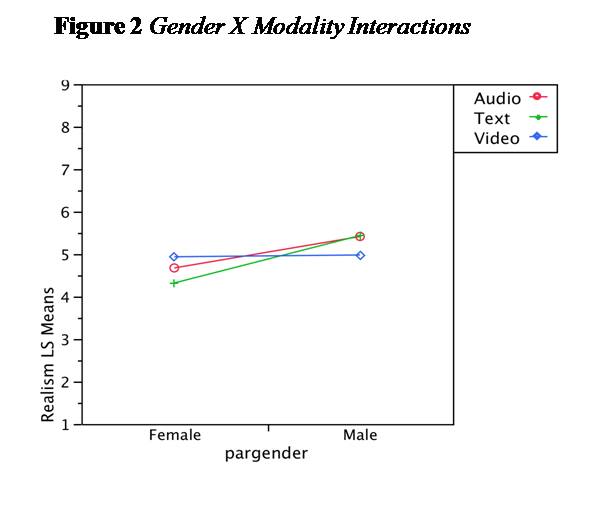Media Effects Research Lab - Research Archive
Do you believe in love at first sight?
Student Researcher(s)
Seoyeon Lee (Masters Candidate);
Yuan Sun (Masters Candidate);
Elizabeth Thiry (Masters Candidate);
Faculty Supervisor
INTRODUCTION
Given the nature of the online dating profiles, users need to make decisions about when, how, and what will be disclosed as part of their self-presentation. Online dating profiles are a crucial self-presentation tool as they are the first and primary means of expressing one’s self during the early stages of a correspondence and can therefore create relationship opportunities. However very little research has been done to determine if using richer media to create profiles will have a positive effect on a viewers overall impression.
RESEARCH QUESTION / HYPOTHESES:
RQ: How does the type of modality used in online profile [(text + picture (text only), text + picture + audio (audio), or text + picture + audio + video (video)] affect overall impression (level of perception, memory, and behavioral intention)?
H1: Participants exposed to richer media are more likely to feel that they have sufficient information to form an impression.
H1a: Participants who perceive that they have sufficient information will have a positive perception toward the person in the profile.
H1b: Participants who perceive that they have sufficient information will have a positive behavioral intention toward person in the profile and the website.
H2: Participants who were exposed to richer media will experience more social presence.
H2a: Participants who experience more social presence will have a positive perception toward the person in the profile.
H2b: Participants who experience more social presence will have a positive behavioral intention toward the person in the profile and the website.
H2c: Participants who experience more social presence will have greater memory for the profile contents.
H3: Participants in richer media conditions will experience more engagement than leaner conditions.
H3a: Participants who experienced more engagement will have a greater perception toward the person in the profile.
H3b: Participants who experienced more engagement will have greater behavioral intention toward the person in the profile and the website.
H3c: Participants who experienced more engagement will have a higher level of memory for the profile contents.
H4: Richer media conditions will prompt the coolness and novelty heuristics more than leaner conditions.
H4a: Participants who experienced more coolness and novelty heuristics will have a greater perception toward the person in the profile.
H4b: Participants who experienced more coolness and novelty heuristics will have a greater behavioral intention toward the person in the profile and the website.
H5: Richer media conditions will prompt the realism heuristics more than leaner conditions.
H5a: Participants who experienced more realism heuristics will have a greater perception toward the person in the profile.
H5b: Participants who experienced more realism heuristics will have a greater behavioral intention toward the person in the profile and the website.
H6: Participants who reported having a greater amount of information are more likely to experience heuristic cues.
H7: Participants in the priming conditions are more likely to engage in heuristic processing than those in the non-priming condition.
H7a: Participants who were in the non-priming condition are more likely to have greater perception toward the person in the profile.
H7b: Participants who were in the non-priming condition are more likely to have greater behavioral intention toward the person in the profile and the website.
H7c: Participants who were in the non-priming condition will have a higher level of memory for the profile contents.
METHOD
275 participants volunteered to take part in the research study, a questionnaire, for extra credit in one of numerous communication and information sciences and technology classes that were sampled at a large public university. When the questionnaire link was clicked, participants were randomly assigned to one of six stimuli conditions: non-priming (text only, audio, or video) conditions or priming (text only, audio, or video) conditions. The questionnaire was made up of 83 questions used to gather demographic information and measures for overall impression, information amount, social presence, engagement, coolness & novelty and realism, and pre-existing attitudes toward online dating. For all the measures a 9-point Likert scale was employed except for cognitive response within overall impression, which used recall and recognition questions.
RESULTS
A multivariate analysis of variance (MANOVA) was conducted to examine the effects of multi-modality format of online profile on participants’ perception toward the person, behavioral intention toward the person and website, and memory by recall and recognition questions. This analysis revealed a significant effect for modality, Wilks’ L = .90, F (12, 516) = 2.27, p < .01. See table 1 for univariate test result.

One-way ANOVAs with the mediation indices yielded a significant effect for perceived information amount, social presence, coolness & novelty and engagement, but no significant effect was found for realism. Participants in the video condition rated significantly higher than their counterparts in the audio condition and text-only conditions (see Table 2). Therefore, our hypotheses 1, 2, 3 and 4 were supported while hypothesis 5 for realism was not supported.

However, a 2 (Gender) X 3 (Profile Modality) analysis of variance revealed a main effect for gender, with males reporting significantly more experienced realism (M = 5.30, SE = .10) than females (M = 4.64, SE = .11), F (1, 260) = 18.38, p <. 001. No main effect for profile modality on perceived realism was revealed, F (2, 260) = 0. 43, p = .65. A Gender X Profile modality interaction was obtained, F (2, 260) = 4.40, p < .05.

In summary, as the media richness of the website profile increases so does the perceptions regarding the amount of information presented, the social presence of the actor/actress to the user, the engagement with the website and the users opinion that the website was cool and novel. As each of the mediators (information amount, social presence, engagement, coolness & novelty) increase so does the perception towards the actor / actress along with the behavioral intention towards both the website and actor / actress. Additionally, as the perceived amount of information provided increases so does the amount of social presence of the actor/actress to the user, the engagement with the website and the users opinion that the website was cool and novel. Furthermore, it appears that the interplay of modality and gender can have significant effects on users' perceived realism. Furthermore, if a user was in the priming condition their overall impressed formed will be less than the non-priming condition. Finally, as the media richness of the website increase so does the overall impressions formed.
DISCUSSION/ CONCLUSION
Although the impact of media richness has been studied in other online contexts (e.g., online news websites), the present study of the effects of media richness was in the online dating environment. For future research, the study’s findings should be extended to the real-world online dating websites and non-college users. Also, the utilization of specific media within the combinations merit future investigation. The present study is the first to examine the impacts of media richness on online dating profile, and offers researchers unique insights into the complex issues of online self-presentation tools, which not only reflect but also have the potential to shape how people form overall impression for one another.
For more details regarding the study contact
Dr. S. Shyam Sundar by e-mail at sss12@psu.edu or by telephone at (814) 865-2173

